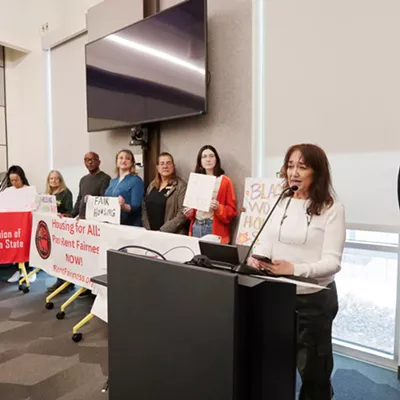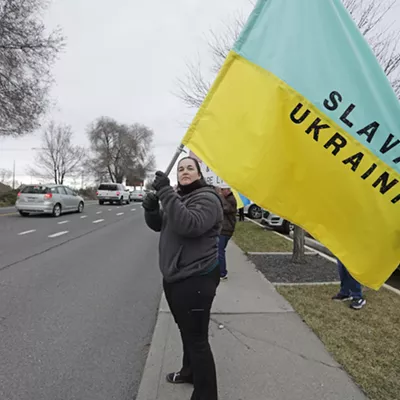It's 7:45 in the morning. You're standing in your skivvies looking at your bleary-eyed self in the mirror as you sluggishly brush your teeth in preparation for yet another day at the office. Over the sound of your children playing in the next room, you detect the faint wail of a siren, rising and falling in pitch somewhere in the distance. You pause, pull the toothbrush from your mouth, and listen. The siren becomes steadily louder, more insistent, its wavelike tones in phase with your surging fear. "Oh my God," you mutter to yourself. "It's gotta be a test."
But it's not a test. It's the real thing, as you discover as soon as you snap on the transistor radio and listen to the grim news reports and the warning signals from the Emergency Broadcast System. The unthinkable is happening. Your government's early warning system has detected the launch of ICBMs from Siberia -- ICBMs targeting Fairchild Air Force Base and Spokane. You have no more than 75 minutes to get you and your family to the nearest fallout shelter, where you'll spend the next two weeks huddled with your neighbors, waiting to come out and survey what's left once the dust has settled. Your mind is racing: Where is everyone? How the hell did it finally come to this? Where's that shelter plan?
The decade following the end of World War II was a time of tremendous prosperity in this country. The post-war economy was robust, with low unemployment figures and an industrial base expanding to meet the demands of the new consumerism. Americans found themselves with more disposable income and more leisure time than ever before. We were enjoying suburban sprawl, the stability of Eisenhower, shopping malls and Howdy Doody.
But there was a dark side to this American life in the 1950s. Tempering our collective optimism concerning the future was the grim realization that all of our plans and everything we were working so hard to achieve could be annihilated in the blink of an eye -- in the brilliant, terrifying flash of a thermonuclear explosion. It was something everyone had to live with, and like the devastating effects of atomic warfare, there was no escaping it. There were weekly air raid siren blasts, Emergency Broadcast System tests on radio and television, "drop and cover" drills in every school and, in Spokane, "Operation Walkout," the mock evacuation of the entire downtown core.
In the April 29, 1995 edition of The Inlander, we recreated Operation Walkout, which occurred on April 26, 1954 at 9:10 am.
"The boundary to be evacuated was Boone to the north, Division to the east, Third to the south, and Monroe to the west. The Old National Bank building had a very large, very loud air-raid siren on its roof. Once a week throughout the 1950s and well into the '60s, City Hall energized it and a resounding wail echoed across the city. But at 9:10 am that day, it was sounded with a purpose other than to remind.
At 9:35, radio and television stations upgraded the [yellow alert] alarm to red alert, which meant for people to get the heck out. Within eight minutes, 11,000 Spokanites left the downtown to points less than a mile away."
Despite the fact that -- thanks to the recent development of high-yield thermonuclear weapons -- a real attack in the mid-'50s would have blasted to rubble or incinerated virtually all of Spokane (including the evacuation points), state and federal civil defense authorities hailed the test as a success, a giant step toward saving lives in the event of nuclear war.
Witness Tom Meenach was interviewed at the time of the story and had this to say about the effort: "It was highly organized. We knew exactly when it was coming. When the bells rang, we all quietly walked out and waited. After 30 minutes, we walked back in." But, he continued, "It was a very futile effort. But at least Operation Walkout was a plan, something to do. It was better than doing nothing."
The specter of nuclear war was something that lurked in the mind of every parent, something that hung like a dark cloud over the childhoods of a generation of kids. Yet during the most feverish years of the Cold War, our government officials were telling us that a nuclear attack was survivable. And so, instead of doing everything within our power as a nation to warm chilly relations with our enemies and defuse the international conflicts that might precipitate nuclear war, we dutifully prepared for it as if it were inevitable.
Time for Plan B
Apparently the powers that be decided simply walking out of downtown was not going to save many lives. So the Spokane County Community Shelter Plan was devised -- matched by similar plans in cities across the country. This was a kind of Worst Case Scenario handbook before somebody trademarked the idea -- a no-nonsense guide to survival in the event of a nuclear attack. It was broken down into 10 sections and included a map of the city with detailed information on shelter locations, emergency procedures, home shelter construction methods and the properties of fallout ("What is Fallout?"). Every household and business was sent a copy and was instructed to display The Plan in a prominent place.
The Plan was the result of a survey conducted by local, state and federal civil defense authorities in the early 1960s as part of a full-fledged, nationwide shelter program funded by the federal government and executed by the Department of Defense. Engineering studies of existing structures all over the country were conducted. Structures found to provide adequate fallout protection were assigned maximum occupancies and stockpiled with enough supplies (food, water, sanitary and medical kits, even candy) to meet the needs of the shelter occupants for a maximum of 14 days. After two weeks (according to The Plan), radiation levels would be safe enough for survivors to return to whatever was left of their lives.
The Plan was to be every citizen's route to survival, whether there was advanced warning or not.
"When I was a kid, we did the 'drop and cover' drills," says Thomas Mattern, the deputy director for the Spokane City/County Department of Emergency Management, the local arm of FEMA, which is now a part of the Department of Homeland Security. "We even had to time how long it took us to get from the school to our homes. But as soon as you started learning about what these weapons can do, you were like, 'Yeah, right.' I mean, we were just going through the motions."
Former Spokane Mayor Jack Geraghty (in 1969 a Spokane County Commissioner) co-chaired the CSP Policy Advisory Committee that helped produce the Plan.
"In 1969, the Cold War was still going on with the Soviet Union," he recalls. "We'd been through the Cuban Missile Crisis, and that was kind of scary. But the thing around here was Fairchild and that we were considered to be a target. Everybody was pretty nervous about that. "
Yet the Plan doesn't seem at all adequate, considering the destructive power and sophisticated delivery systems of the weapons at that time, leading one to speculate if the concept of preparedness was either a lie, wishful thinking or a simple matter of "something is better than nothing."
"It was almost like some of the knee-jerk reactions after 9/11," says Geraghty, "where we were obsessed with concerns over what would we do if it happened again. We thought the best way to protect yourself or your family from being harmed was to go down into a hole. If you think about it, in the big picture, it probably wasn't a rational thing. But for awhile there, it was almost a nationwide frenzy."
How Safe Do You Feel?
I remember the weekly air-raid siren tests that would rip through my suburban Spokane neighborhood when I was a kid in the mid-1970s. It happened every Wednesday at noon, just as I was having lunch. My friends and I all knew that Fairchild AFB was just over the western horizon and that the Soviets had designated it a primary target. If nuclear war ever broke out between the superpowers, we assumed that we would be some of the first to die. I remember being pretty fatalistic about it, thinking that if it ever actually came to that, I would set up a lawn chair on the roof of our house, face west, watch the pretty lights and wait for the blast to engulf me. My mom tells me that before I was even in school, I used to freak out every time the TV or radio went through the piercing Emergency Broadcasting System drill. I would run and hide behind a chair and try to reassure myself and her that, "It's just a test, Mommy. It's just a test."
It was a weird time to be a kid.
"When I was a little kid in the '50s, there was quite a bit of hysteria about bombs and stuff," recalls Geraghty. "I remember one night waking up at our house during a thunderstorm, and there was this terrific clap of thunder and I thought for sure that an H-bomb had gone off at Fairchild and that we were all toast. It's bizarre. People had that in the back of their minds all the time."
To some degree, we live with that threat today. Except that now, in post-9/11 America, instead of a clearly defined nemesis with H-bomb-tipped ballistic missiles pointed our way, we have to contend with an enemy of unknown origin and tactics with nuclear devices that can be tucked into a briefcase. During the Cold War, if the attack were to come, we would have had a pretty good idea where it would have come from and what it would have looked like. Not so with today's situation. Ah, don't you miss the good old days of simple, clearly defined evil?
"The irony is all of a sudden the Department of Homeland Security is going around telling people they should have these survival kits," says Geraghty. "In a way, it's almost like d & eacute;j & agrave; vu."
Mattern says that even before 9/11, the federal government (notably, FEMA and the new Department of Homeland Security) was showing renewed interest in national preparedness or civil defense: "Things are really weird right now. About 1996, information started coming in from disaster relief to homeland security. The wheels were rolling even before the 9/11 attacks. After Oklahoma City and the first World Trade Center bombings, they were looking. They knew something was coming. So there is definitely a new emphasis on civil defense. But it's not about a bomb taking out Spokane anymore. It's about isolated threats -- dirty bombs and planes crashing into buildings. The mode of attack has changed."
As we should have learned during the Cold War, we can't lull ourselves into a false sense of security -- nor can we just set up a lawn chair to watch the fireworks. We as a nation seem to have two choices. We can dismiss international grievances against the United States, reduce our foreign policy to a simplistic "with us or against us" stance, isolate ourselves, adopt a defensive posture and prepare for the worst. Or we can devote our energies and resources to the notion that peace and justice should be a way of life for everyone living on the planet -- not only for those in countries vital to our national interests.
One consigns us to a future of fear -- not far from the world we lived in during the 1950s and '60s -- while the other sounds like a plan we can all live with.
Comments? Share them at totheeditor@inlander.com
Publication date: 05/20/04
















